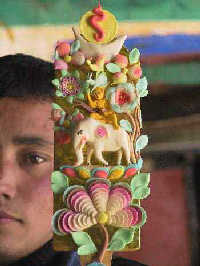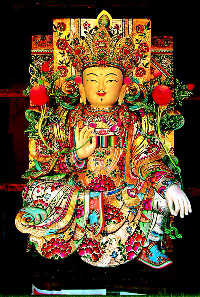 Offerings molded from butter, or butter sculptures, are central to spiritual development in Tibetan Buddhism. As a unique sculptural art in Tibetan culture, the art has an origin in the area's indigenous Bon religion and is considered an exotic treasure of Tibetan art.
Offerings molded from butter, or butter sculptures, are central to spiritual development in Tibetan Buddhism. As a unique sculptural art in Tibetan culture, the art has an origin in the area's indigenous Bon religion and is considered an exotic treasure of Tibetan art.
 Origin of butter sculptures
Origin of butter sculptures
In 641, when Princess Wencheng of the Tang Dynasty (618-907) went to Tibet to marry the king of the Tubo Kingdom (629-846), Songtsan Gambo, she brought along a sculpture of Sakyamuni (Buddhist founder), which was later enshrined and worshipped at the Jokhang Temple.
To show their respect, the Tibetans presented offerings in front of the Buddha. According to the traditional customs observed in India, offerings to Buddha and Bodhisattvas were divided into six categories: the flower, Tu incense, divine water, Wa incense, fruit, and the Buddha light. By that time, however, all of the flowers and trees had died, so the Tibetans made a bundle of flowers from butter instead.
Butter sculptures are a kind of butter-molded craftwork where the major raw material is butter, a creamy food among the Tibetans in China. The solid material, which is soft and pure with a faint scent, can be molded into vivid, bright, and exquisite craftworks.
In the beginning, butter sculptures were simple and the techniques were rough. Later, two institutions were set up in the Taer Monastery to train monk artists specializing in this art. With a passion for Buddha and the arts, the monks worked hard and learned from each other to overcome their own weaknesses, thus enriching the art in terms of pattern and content.
 Making of butter sculptures
Making of butter sculptures
The making of butter sculptures is rather unique and complex: Since butter melts easily it is modeled by hand in cold conditions (usually on winter days) by monk artists.
To make the butter more smooth and delicate, the monk artists soak it in cold water for a long time to remove impure substances; then, they knead the butter into a smooth yet greasy preparation.
 Before sculpting, monk artists must wash and take part in a religious ritual. Then, they begin to discuss the theme of the butter sculpture. After setting the theme, they elaborate on the concept, planning, and layout of the butter sculpture. During this process, the work is distributed among the monks respectively. When all of the preparatory work is complete, the artists enter rooms at a temperature of 0℃ and begin to sculpt.
Before sculpting, monk artists must wash and take part in a religious ritual. Then, they begin to discuss the theme of the butter sculpture. After setting the theme, they elaborate on the concept, planning, and layout of the butter sculpture. During this process, the work is distributed among the monks respectively. When all of the preparatory work is complete, the artists enter rooms at a temperature of 0℃ and begin to sculpt.
The first procedure is for the artist to set up a basic frame for the butter sculpture, using some simple tools, such as soft leather, hemp rope, and hollow truncheon (Do you mean a hollow stick of some sort?).
In the next procedure, modeling, the artist employs two kinds of raw materials.
The first kind is a black mixture made from the used butter sculptures and ashes from burned wheat straw to mold different shapes on the frame. This process greatly resembles flour sculpting and clay sculpting. Then, the body must be revised and examined before the model is finally set up.
